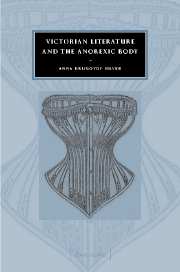Book contents
- Frontmatter
- Contents
- Acknowledgments
- Introduction
- 1 Waisted women: reading Victorian slenderness
- 2 Appetite in Victorian children's literature
- 3 Hunger and repression in Shirley and Villette
- 4 Vampirism and the anorexic paradigm
- 5 Christina Rossetti's sacred hunger
- Conclusion: the politics of thinness
- Notes
- Bibliography
- Index
- CAMBRIDGE STUDIES IN NINETEENTH-CENTURY LITERATURE AND CULTURE
1 - Waisted women: reading Victorian slenderness
Published online by Cambridge University Press: 22 September 2009
- Frontmatter
- Contents
- Acknowledgments
- Introduction
- 1 Waisted women: reading Victorian slenderness
- 2 Appetite in Victorian children's literature
- 3 Hunger and repression in Shirley and Villette
- 4 Vampirism and the anorexic paradigm
- 5 Christina Rossetti's sacred hunger
- Conclusion: the politics of thinness
- Notes
- Bibliography
- Index
- CAMBRIDGE STUDIES IN NINETEENTH-CENTURY LITERATURE AND CULTURE
Summary
The extraordinary variety that is woman's body is systematically ignored in our culture. The richness of our different shapes is reduced to the overriding image of slimness.
Susie Orbach, Fat is a Feminist IssueIt has always appeared to me to be one of the greatest existing absurdities, that a whole community of people, differing in complexion, form, and feature, as widely as the same species can differ, should … desire to wear precisely the same kind of dress.
Sarah Stickney Ellis, Daughters of EnglandThe remarkable similarity between Orbach's and Ellis's observations indicates that the wish to adapt to one predominant standard of beauty bridges nineteenth- and twentieth-century women's experiences, and that contemporary complaints about the tyranny of slenderness have antecedents in the Victorian era. Nineteenth-century writers were well aware of the importance of beauty, including slenderness, in women's lives, so discussions of the existence of a Victorian “beauty myth” do not merely impose a twenty-first-century concept upon the nineteenth century. Beauty has, of course, concerned both men and women throughout history, but Ellis's statement alludes to a specific body type that many women cultivated in order to conform to a fashionable Victorian silhouette, “to wear precisely the same kind of dress” as their neighbors. Ellis's interpretation of women's behavior, therefore, requires an investigation into the body types that most appealed to fashionable Victorian women.
- Type
- Chapter
- Information
- Victorian Literature and the Anorexic Body , pp. 25 - 50Publisher: Cambridge University PressPrint publication year: 2002
- 1
- Cited by



